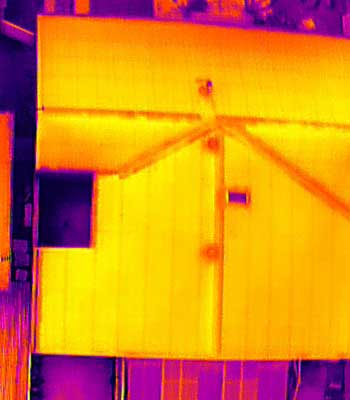Thermal Imaging
- Home
- Our Services
- Thermal Imaging
Thermal Drone Inspections
Key Benefits of Drone Thermal Inspections

Risk Mitigation & Cost Efficiency
- Detect electrical faults (loose connections, overloaded circuits) 8–12 weeks before failure.
- Reduce fire risks and unplanned downtime by 63% (based on industry benchmarks).
- 40–70% cost savings vs. manual inspections, with no operational disruptions.
Insurance & Compliance Readiness
- Thermal datasets formatted for third-party certification (aligns with AS/NZS 3017:2024 standards).
- Geotagged and timestamped images and reports support insurer submissions (QBE/Allianz-compatible).
*Third-party insurance standard certification provided up to mid June 2025 – after which, PDI will have the qualifications to provide insurance standard datasets in accordance with ISO 18436-7.
Core Service Applications
Electrical System Diagnostics
Identify Hotspots: Detect anomalies in electrical systems, such as overheating components, faulty connections, or overloaded circuits, using thermal imaging cameras.
360° Substation Scans: Perform comprehensive thermal scans of substations to identify potential issues before they become major problems.
Solar Panel Arrays
Commercial Rooftop Inspections: Identify defective solar cells, micro-cracks, and shading issues in commercial rooftop solar panel arrays to optimise energy production and reduce maintenance costs.
Efficient Inspection Process: Conduct thorough inspections of rooftop solar installations quickly and efficiently, reducing downtime and ensuring maximum energy output.
Mechanical Inspections
Detect Bearing Issues: Identify abnormal friction in bearings, which can indicate under-lubrication, over-lubrication, or poor maintenance.
Motor Health Assessment: Assess motor health by detecting thermal anomalies indicative of internal faults or cooling issues.
Thermal Resistance Inspections
Insulation Integrity: Verify the integrity of insulation in buildings and industrial equipment to identify heat leaks or damaged insulation.
Refractory Condition: Evaluate the condition of refractory linings in furnaces and boilers to detect degeneration or heat loss.
Thermal Capacitance Inspections
Roof Moisture Detection: Identify areas of excess moisture in roofing insulation, which can lead to structural issues or energy inefficiency.
Non-Invasive Leak Detection: Detect moisture leaks without damaging the roof, saving time and resources.
Physical State Inspections
Gas/Liquid Interface Detection: Identify the interface between different states of matter, such as gas/liquid or liquid/solid transitions.
Temperature Monitoring: Monitor temperature changes in processes or systems to ensure optimal operating conditions.
Building Inspections
Energy Efficiency Assessment: Evaluate building envelopes for heat loss or gain, identifying areas for energy efficiency improvements.
Moisture and Air Infiltration Detection: Detect hidden moisture issues or air leaks in walls and roofs.
Process Inspections
Fluid Flow Monitoring: Monitor fluid flow in pipes and tanks to detect blockages or leaks.
Steam and Vessel Level Inspection: Inspect steam systems and vessel levels to ensure proper operation and safety.
Energy-Related Inspections
Solar Panel Performance: Assess the performance of solar panels by detecting overheating or malfunctioning components.
Cold Room Inspections: Inspect cold storage facilities to ensure proper insulation and temperature control.


Data Collection Process

Step 1: Pre-Inspection Planning
Site-specific risk assessment (electromagnetic interference, airspace compliance)
Custom flight paths avoiding reflective surfaces (glass, polished metals)
Step 2: On-Site Operations
DJI Mavic 3T Enterprise captures:
Radiometric thermal JPEG/R-JPEG (16-bit)
RGB DNG (RAW) and 48 MP visual images
Geotagged CSV temperature logs
Step 3: Post-Processing
DJI Thermal Analysis 3.0 for isotherm configuration and anomaly tagging
PIX4D photogrammetry for 2D/3D thermal-visual overlays
Deliverables
Compliance Reporting with a Licenced Electrician for Certification & Insurance Compliant reporting.
Raw thermal/visual files (JPEG, DNG, CSV)
Optional
- P1–P5 prioritisation framework (custom ΔT thresholds) see more below.
Thermal Inspections FAQ
Why Choose Drone Thermography?
Non-Destructive Testing (NDT): Inspect live electrical assets without shutdowns.
Speed: Cover 16+ hectares (i.e. Solar Farms) daily vs. manual methods.
Access: Thermal Drones can access difficult or hazardous areas internally or externally.
Safety: Eliminates elevated work risks for personnel.
What is AS/ISO 18436-7?
ISO 18436-7 is an international standard that outlines the requirements for the qualification and assessment of personnel involved in machinery condition monitoring and diagnostics using infrared thermography. This standard is part of the broader ISO 18436 series, which focuses on condition monitoring and diagnostics of machines.
In Australia, the equivalent standard is AS 18436-7, which ensures compliance with local regulations and industry standards for thermographic inspections.
ISO 18436-7 ensures that thermographers are properly trained and certified to perform accurate thermal analyses, contributing to predictive maintenance and fault detection in various industries.
What Affects Thermal Accuracy?
Emissivity: Our Thermology Imaging Specialists adjust settings for materials (e.g., metals vs. insulation).
Reflections: Flight angles optimised to minimise false readings from reflective surfaces.
Environmental Factors: Surveys timed to avoid sunlight/shadow interference.
Priority Classification Framework P1-P5
Implementation of the Prioritisation Framework P1–P5 (custom ΔT thresholds) .
P1 (Critical)
Definition: Immediate attention required due to severe operational impact
Example Scenario: Temperature anomalies indicating imminent equipment failure (e.g., transformer hotspots exceeding 150°C) that could cause facility-wide power outages
Response Protocol:
- Site shutdown recommended within 24 hours
- Emergency repair coordination required
P2 (High)
Definition: Significant risk requiring resolution within 48 hours
Example Scenario: Solar array bypass diode failures causing 10-15% energy loss across multiple PV strings
Response Protocol:
- Scheduled maintenance within 72 hours
- Continuous thermal monitoring until resolution
P3 (Moderate)
Definition: Non-critical faults needing attention within 7 days
Example Scenario: Insulation gaps in cold storage facilities increasing energy consumption by 5-8%
Response Protocol:
- Include in next planned maintenance cycle
- Quarterly re-inspection recommended
P4 (Low)
Definition: Minor anomalies for monitoring/documentation
Example Scenario: Sub-2°C temperature variations in low-load electrical connections
Response Protocol:
- Log for trend analysis
- Annual re-evaluation
P5 (Informational)
Definition: Baseline variations requiring no action
Example Scenario: Expected thermal patterns in properly functioning equipment
Response Protocol:
- Archive for historical comparison
Key Features of the Priority Framework:
Custom Thresholds: ΔT values adjustable to client risk profiles
Impact-Based: Priorities reflect operational consequences rather than absolute temperatures
Integration-Ready: CSV priority flags compatible with IBM Maximo/SAP
Adaptation Guidance:
- Clients may modify criteria through our configuration portal to align with:
- Insurer requirements (e.g., QBE/Allianz thresholds)
- AS/NZS 3017:2024 maintenance schedules
- Facility-specific criticality matrices
Our Thermology Imaging Specialists provide raw thermal data with optional priority tagging – final validation of severity classifications remains the client’s responsibility.
Framework designed for maintenance planning only – does not constitute certified diagnostic analysis.
Note: In a thermal process, delta T (or ΔT) is the value that indicates the difference between two measured temperatures.
How Is Thermal Data Used?
Clients engage third-party consultants and analysts to:
Generate insurance-compliant reports
Validate repair priorities (P1–P5 framework)
Trend thermal anomalies over time
What are the benefits of choosing a Qualified Thermographer?
Compliance and Benefits:
Importantly, many insurance companies require thermal inspections to be conducted by qualified thermographers, and our certification meets these standards.
From June 2025, by choosing our team, you can ensure compliance with insurance requirements and benefit from enhanced predictive maintenance and condition monitoring, all delivered through comprehensive reports that empower you to make informed decisions about your assets.
This format makes it easier for readers to understand your team’s capabilities and the benefits of working with certified professionals.
How is Thermal Imaging Priced?
Site Surveys: From $1,267/day (ex. GST)
Assets Scanned: 40-50 per day
Data Packages: Includes raw JPEG/DNG files, CSV logs, and flight metadata if required
Compliance & Limitations
CASA Regulations:
15m clearance from live assets, BVLOS restrictions apply internally and externally.
Diagnostic Disclaimers:
- PDI does not provide certified thermography reports we provide qualified inspections which can be certified by a third-party if required.
- Clients assume liability for data interpretation/insurance compliance.
At PDI, we are committed to providing high-quality thermal inspection services. We have booked our Category I Infrared Thermography course for June 2025, which will equip us with the necessary skills to conduct basic infrared surveys, set up and operate thermal imaging equipment, and perform basic fault detection.
Future Capabilities
Upon completing the course, we will be qualified to conduct a range of thermal inspections, including electrical, mechanical, and building inspections. We will be able to identify potential issues, evaluate and report test results, and provide actionable insights to enhance predictive maintenance and condition monitoring.
Qualification Pathway
We understand the importance of gaining practical experience and are committed to achieving full qualification as thermographers. Following the completion of our training, we will continue to gain hands-on experience, aiming to meet the requirements for full certification within the next year. This includes completing 400 hours of thermal inspections and 12 months of experience.
Why Partner with PDI?
CASA-Accredited Expertise: ReOC/RePL/AROC – certified Remote Pilots
Advanced Technology: DJI Mavic 3T with 640×512 thermal resolution
Transparent Outputs: Observational data provided in imagery and reporting
Why Choose Us
By choosing our team, you will be working with professionals who are dedicated to delivering high-quality services and committed to ongoing professional development. We believe in transparency and want to assure you that we are taking all necessary steps to ensure our services meet industry standards. This is something our local competitors can’t offer you.
We are the smart, safe and qualified choice for your thermal inspection needs.



